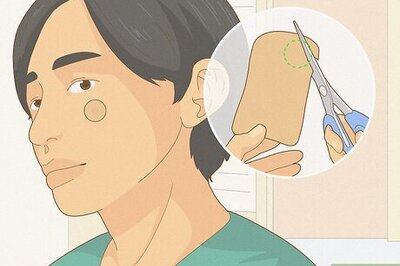
views
X
Research source
Keep in mind, you need a strong, horizontal object to hang the straps that hold the rings if you want to work out outside. Luckily, it’s pretty easy to set the rings up and adjust them once you find a good place to hang the straps.
Choosing a Place to Hang the Rings
Select a hanging location that is 8–13 ft (2.4–4.0 m) off the ground. The straps for gymnastic rings are adjustable so the height doesn’t matter if you’re only doing exercises under the rings, but you need a good bit of space if you plan on lifting your body above the rings or spinning around. When scouting good locations, look for horizontal surfaces that are at least 8–13 ft (2.4–4.0 m) above the ground so you have plenty of space to work out. Most people hang the rings up when they want to work out and take them down when they’re done. You can leave the rings up permanently if you’re hanging them from a structure in your yard or driveway, though. It’s really up to you. Some people use gymnastic rings to do modified pushups and other low-hanging exercises. If this is what you’re using them for, you can hang the straps from anything 4–5 ft (1.2–1.5 m) off of the ground.
Put the rings in an area with at least 6–8 ft (1.8–2.4 m) of clearance on each side. You must have some room to work if you plan on doing any exercises that involve spinning, sticking your feet out, or rotating your body on the rings. Look for a hanging location that has at least 6–8 ft (1.8–2.4 m) of clearance in every direction if you plan on doing any advanced exercises on the rings. If you’re only doing pullups or pushups with the rings, it doesn’t matter how much clearance you have.
Use a strong tree branch as a convenient platform for the rings. If there are any large, mature trees nearby, look for a thick branch you can hang the straps from. Branches are a good choice if you don’t want to travel far to workout. They’re also a great option if you have a large tree in your backyard or you live near a park. If you hang the rings on a branch, pull hard on them and hang with your feet off of the ground to make sure the branch doesn’t sway or buckle. If it can hold your body weight when you pull on the straps, you can use the branch to do any exercise on the rings. The branch doesn’t need to be perfectly horizontal. The straps are adjustable, so you can compensate for a height difference between two points on a branch. However, the branch can’t tilt at too hard of an angle; the straps may slide down the branch while you’re using them if you hang them on a branch with a slope steeper than 15 degrees.
Find some tall monkey bars at a playground for a stable, easy option. Tall monkey bars are perfect for gymnastic straps, but they can be kind of hard to find. Most playgrounds don’t have tall monkey bars, but you may be able to find some that hang 8–9 ft (2.4–2.7 m) off of the ground. Just try to time your workouts so you aren’t running into tons of children. You can use a pull-up bar at a public park, but most of these bars are designed to be reached from the ground and they may not be high enough if you’re doing any exercises over the rings. Many pull-up bars don’t have a ton of room on the sides either, which can make them dangerous if you don’t have immaculate balance.
Use the bars on the back of a basketball hoop if you live near a court. If you live near a basketball court that doesn’t see much use, look behind the backboard. If there are two lengths of metal supporting the backboard, you can hang your rings from these bars. These are great because they give you plenty of room to work. You’ll just need to time your workout around pickup games. This is probably the best option if you have a basketball hoop built into your driveway or backyard. Keep in mind, you cannot use one of those freestanding rims to do this. It must be a hoop that is mounted directly into concrete.
Look for an exposed joist on an unfinished ceiling to hang them at home. If you have an unfinished overhang, garage, or carport, you can hang your rings from one of the joists. This is the perfect option if you want to hang them at home and you have an exposed ceiling outdoors, but you may not have this option available depending on where you live. This is a great option if you want to leave the rings up permanently since the ceiling will protect the rings from the rain and snow. A garage isn’t technically outside, but it may as well be if you open the door while you’re working out!
Build a ring frame in your yard if you’re ambitious and good with tools. You can always make your own ring frame if you have a yard. Dig two 4 ft (1.2 m) holes into a grassy area and place them 8–10 ft (2.4–3.0 m) apart. Install two 4 by 4 in (10 by 10 cm) beams in the holes you dig. Use beams that are 12–16 ft (3.7–4.9 m) tall. At the top of each beam, use wood screws and a drill to install round brackets for a horizontal metal bar. Fill in the holes around the wood beams with instant concrete and gravel. This is a great option if you want to do a lot of ring work in the privacy of your own yard, but you may not want a permanent frame sitting in your backyard. If you aren’t already good with power tools and working with your hands, this isn’t a safe option. If you don’t build the frame correctly, it may break while you’re using it.
Buying Your Rings and Straps
Get wood rings if you want the best grip and live in a dry climate. Wood rings are widely-recognized as the best option, but they’re a little more expensive than plastic or metal. They offer the best grip and they’re less likely to irritate your hands or cause calluses. The wood will also absorb sweat from your hands which makes it a lot harder to slip when you’re hanging from the rings. Unfortunately, wood doesn’t hold up great in the elements. If you plan on leaving the rings outside permanently or you live in an area that experiences a lot of extreme weather, they may not be the best option for an outdoor setup. Expect to spend $40-60 on a set of wood rings.
Purchase plastic rings if you plan on leaving them outside. Plastic rings aren’t nearly as comfortable to use as wood, but they’re a better option if you plan on leaving the rings outside since they’ll stand up in any climate. If you really don’t want to bother setting the straps up every time you work out, purchase some plastic rings. Expect to spend $15-30 on a set of plastic rings. Some of these rings are made with non-slip materials. Non-slip rings are better than the regular plastic rings if you’re worried about the rings sliding out of your hands, but they tend to cost just as much as a wood set.
Get metal rings if you’re doing simple exercises and you want the rings to last. Metal is a popular choice among users that don’t get fancy on the rings with the inverted gymnastics and crazy spins. Metal rings tend to be very hard on your hands if you’re getting acrobatic, but they’re fine if you’re just doing pullups and simple exercises. They also tend to last forever in basically any environment, which is great if you plan on leaving them outside. These metal rings are often made of steel or a steel-blend. Expect to spend $30-40 on metal rings.
Purchase some 15 ft (4.6 m) straps if they don’t come with the rings. Almost every set of rings will come with the straps you need, but if you’re using some old rings that don’t have straps or you purchase the rings separately, but some gymnastic ring straps. These straps are universal and any set will work with any rings. They’re also almost always 15 feet (4.6 m) in length, but just double-check to make sure you aren’t getting some super long straps. You’ll likely need to pay an additional $15-30 if you’re buying the straps separately. If your rings aren’t particularly nice or new, it may be worth it to simply buy a new set. The straps come with Velcro tabs. Sometimes the Velcro tabs are attached to the straps, but you’ll need to remember to bring them with you when you exercise if they’re separate pieces.
Assembling the Straps and Rings
Throw the fabric end of the strap over the object you’re hanging it from. Take the end that doesn’t have the buckle on it and toss it or wrap it around the object you’re hanging it from. Grab it from the other side of the bar and pull it down so an equal length of fabric hangs on each side of the bar, beam, or branch. If you throw the end with the buckle on it, it may break against the ground if you don’t catch it. You can complete each step twice and set up both rings at the same time, or assemble each strap separately. It doesn’t really matter.
Unravel any wrinkles or twists in the strap. Twist each side of the strap as needed to undo any knots or wrapped-up fabric. Adjust each side as needed so that the buckle on the end of the strap is facing out away from the object you’re hanging the rings from. You can hang the rings just fine if the buckle is facing inwards, but it’s a lot easier if it’s pointing out away from the bar.
Slide the middle of the ring through the strap without the buckle. Let the end with the buckle on it hang while you pick the ring up and run the empty end of the strap through the middle of the ring. Grab the buckle once the ring is in the strap and let the ring hang on the fabric while you work on completing the rest of this process. Once the rings are attached to the straps, they’ll rotate and hang freely in the air. You don’t need to worry about the rings facing a certain direction; you can just turn them as needed with your hands.
Insert the empty end of the strap into the slit on the back of the buckle. Grab the empty end of the strap in your dominant hand and lift the buck up so that the clip on the front is facing away from you. On the back of the buckle, look for a thin slit in the metal just below the point where the buckle attaches to the strap. Slide the empty end of the strap horizontally through this slit. Some people automatically assume that the empty end slides through the front of the buckle. Never do this. The strap will not lock if you run the fabric on the empty end through the front of the buckle.
Feed the end of the strap through to the front of the buckle. With the empty side inserted in the slit, continue pushing the strap through the back of the buckle. It will automatically catch on the track inside of the buckle and poke out the front on the other side. The buckle automatically locks the strap in place. You can keep pushing it through, but you can’t pull it out. So long as you don’t press the clip on the front of the buckle, your straps are safely locked.
Pull the empty end down until the ring hangs at the desired height based on your preference. The loop you’ve assembled with the straps will continue to get smaller the farther you pull the strap through. The smaller the loop is, the higher the ring will hang. Continue pulling the strap down through the buckle until the ring is 5–7 feet (1.5–2.1 m) off of the ground depending on how high you want it. If you are doing pullups, you want it higher off of the ground. If you’re doing a lot of lower body exercises, you can leave the rings next to your chest. It’s really up to you. If you accidentally make the strap too tall, press the clip on the front of the buckle to unlock the strap and slide it down. Release the clip to lock the strap again. Hang both rings so they rest at an identical distance off of the ground. Don’t worry about it being perfect—an inch or centimeter of difference won’t dramatically change anything.
Use the Velcro straps to wrap the excess fabric to the loop. Once the rings are at your desired height, there will be 3–6 feet (0.91–1.83 m) of excess strap hanging from the buckle. Every set of straps comes with a set of Velcro tabs. Bunch the hanging fabric up into a few loops and hold the loops against the strap above it. Then, wrap a Velcro tab around the loops and the strap to keep the hanging length from getting in your way while you exercise. On some straps, the Velcro is built into the straps themselves. If the tabs came separately and you forgot to bring them with you, just tie the excess fabric in a loose knot to the strap. You can also let it hang and just try to not let it bother you if you prefer.
Press the clip on the buckle down to unlock the straps when you’re done. Slide the loop around so that the buckle hangs at the lowest point. Press the clip on the front of the buckle and pull the empty end back through the buckle until the loop is undone.



















Comments
0 comment